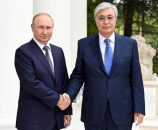- Raja Javed Ali Bhatti
Vishwa Hindu Parishad (VHP) has called for a complete ban on Tablighi Jamaat and its Nizamuddin Markaz besides freezing its bank accounts and closure of all its offices for spike in COVID-19 cases across India.Coronavirus cases are not specific to any community. However, extremist government of BJP in India is especially targeting Muslims to fulfill their evil designs. Vishva Hindu Parishad (VHP) was founded on 29th August 1964, on the auspicious day of Shri Krishna Janmashtami , with the blessings of the Saint shakti of Bharat. It is basically anti muslims extremist Hindu organization . The objective of the VHP is to organise- consolidate the Hindu society and to serve – protect the Hindu Dharma. A strong, effective, enduring and an ever increasing presence of VHP is seen in lakhs of villages & towns in Bharat. With an increased Hindu activity all over the world.In demolishing of Babri Mosque VHP was a key player.Wearing Muslim skullcaps, colorful turbans of Indian Sikhs or hip beanies of secular university students, thousands protested at the largest mosque in India’s capital, a turbulent scene that played out in multiple cities across the country. They defied government curfews, internet shutdowns and the divisive politics that have kept them apart for years.The unrest is increasingly violent, started over a contentious citizenship law that favors every other South Asian faith over Islam. It has since evolved into a broader fight over what demonstrators say is an increasingly authoritarian government bent on dismantling India’s foundation: a secular nation that draws strength from its diversity. “You just needed a trigger,” said Jasbir Singh, a Sikh information technology worker who joined the protests in Bangalore. “In India, religion never decided your citizenship, and it should not in the future.”More and more people are pouring into the streets, and many have clashed with police officers. Six protesters were killed in several towns in northern India, according to officials and the Indian news media, as officers used water cannons, tear gas, wooden sticks and – according to some reports – live ammunition against the demonstrators. Three more were reported killed, raising the death toll to at least 17 since the first protests erupted. The protests have emerged as the biggest challenge yet to Prime Minister Narendra Modi and his agenda. His governing Bharatiya Janata Party has not shied away from articulating its vision of India as a homeland for Hindus. Mr. Modi has tried to play down the diversity of the crowds, describing the protesters as disgruntled Muslims and saying that they could be “identified by their clothes.” But the anger over the law is widespread, with Indians of various political stripes, creeds and backgrounds worried that one religion could become dominant. It has galvanized university students, mirroring a pushback against conservative forces around the world. It has drawn in activists, intellectuals and professionals, continuing a long tradition of protests in India. “Those who want to implement discriminatory laws want to do a second partition, as if the millions dying in the first one wasn’t enough,” said Mr. Singh, the technology worker, referring to the bloody sectarian violence that unfolded in 1947 when the subcontinent was split, establishing India and Pakistan. “After seeing so many people protesting in Mumbai and Bangalore, I feel that old India is still alive.” Protesters are also growing tired of Mr. Modi’s sectarianism as the economy sputters. At the polls, some Indians had put aside their apprehension of the prime minister, attracted to his economic plans. The country’s growth rate has now fallen to its lowest level in six years. “A lot of people voted for Modi because of the economic issues and corruption. Now, the economy is in real bad shape and corruption has not gone down,” said Aadhira Gaikwad, 26, an advertising professional who protested in Mumbai. “All he is doing is using religion to hide under the real issues.” “When the prime minister of this country says protesters can be identified by their clothes, it just fuels the fire,” Ms. Gaikwad added. “This is what he has done all these years.” For India’s Muslim population, the protests are deeply personal. Muslims have watched the rise of Hindu nationalism under Mr. Modi with a wary eye. Dozens of Muslims have been lynched by angry Hindu mobs, with the perpetrators often walking free. The country’s only Muslim-majority state, Jammu and Kashmir, was stripped of its autonomy in August, and thousands of young men and elected politicians were detained without being charged. And the Supreme Court, in a case known as “Ayodhya,” ruled that a temple could be built at the site where a centuries-old mosque once stood before a Hindu mob tore it down.


